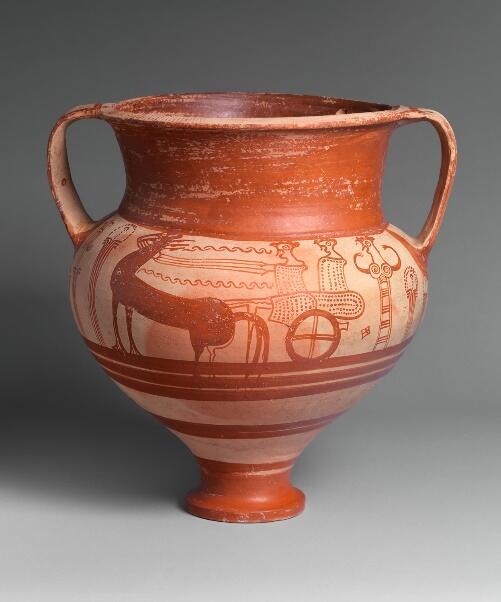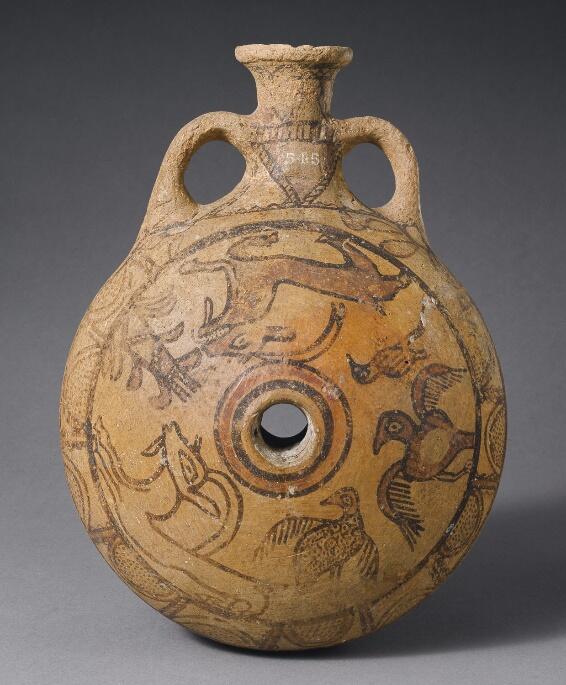Introduction
The evolution of art in various cultures across different regions and time periods had its differences and similarities with one another. Pottery is one of the most frequently discovered forms of ancient art due to its inherent ability to preserve itself. The purpose of this paper is to analyze and compare two pieces of terracotta art found in the Metropolitan Museum of Art, named Terracotta Chariot Krater and Terracotta Lentoid Flask.
Terracotta Chariot Krater
The Terracotta Chariot Krater is dated during the late Helladic Period, having been made approximately during the 12th-13th century BC (“Terracotta chariot crater,” 2019). It is a vessel with a wide opening at the top, two handles on either side and a narrowing down to the bottom. It is decorated with pictures of chariots and people in masks.

The purpose of the krater is unclear, though there is strong evidence that it was used as a funeral vessel in order to house offerings to the gods or even the cremated remains of the body itself as a sarcophagus. The artwork itself represents Mycenaean culture, which had its golden age around the 13th century BC and later evolved into Minoan Cretan culture (“Terracotta chariot crater,” 2019). Likewise, it was centered around the island of Crete and the north-eastern countries of the Mediterranean basin.
Terracotta Lentoid Flask
The terracotta lentoid flask is an example of a practical piece of art to be used in everyday life. It is a flask with two small handles made for fingers near its bottleneck and a hole in the middle of the vessel for a rope to be put through it, enabling to strap it onto a hook or a horse harness.

The flask itself represents Levantine culture, which was prevalent throughout the 11-13th century BC in countries like Syria, Lebanon, Iraq, Palestine, Egypt, and Turkey (“Terracotta lentoid flask,” 2019). It is covered with pictures of goats, birds, and plants on either side. The vessel itself was found in Cyprus, suggesting that the flask was made to be traded inside of the region.
Visual Form Analysis
Both vessels have a form to optimize their use for their respective roles, with one being a funeral vessel and the other being a drinking flask. The wide top of the krater allows placing the ashes and various goods to be offered to the gods without difficulty or interference, with two handles ensuring the ease of transportation. The walls of the krater are relatively thin and fragile, indicating that this was supposed to be a ritual vessel rather than a utilitarian one.
The images illustrated on the sides of the krater are typical of the Mycenean art style, which is characterized by its schematic illustrations of objects, animals, and people (Jones & Alberti, 2014). The picture of the chariot represents the path into the afterlife, with other people in the composition being the priests and the family of the deceased. Another important design detail is the use of symmetrical shapes and partitions on the peoples’ bodies, which demonstrates the artist’s relation to the Mycenean art style.
The terracotta lentoid flask, on the other hand, is made of a much sturdier type of terracotta, indicating its purpose as a day-to-day item. It is decorated with pictures of animals and birds, which was a common motive for many cultures during the Bronze Age Period. The animals are drawn in a Levantine style, with some of them portrayed with respect to their anatomy, while the others (birds in particular) are humanized by their upwards stature and skeletal-like structure, which is an antecedent to Cypro-archaic vase style (Glatz, 2016). There is also an imitation of foliage around the outer contour of the flask. Primarily colors for decoration are different shades of brown.
Comparisons and Contextual Links
The choice of materials and decorations illustrates different purposes for every item, both in the artistic and practical choice of shapes. Both vessels are similar in that they have depictions of creatures and events in a circular form around themselves. However, while the krater has the pictures go around it like a belt, the lentoid flask has them on either of the two sides. These choices were made because of the size and shape of the pottery.
The composition on the krater is unique, created to depict a certain event and a certain family. Its purpose is more symbolic rather than artistic. The flask was meant to be used in everyday life and to please the eye of the beholder. Therefore, while the pictures of animals are entertaining, they serve a purely decorative function. Lastly, the flask presents an amalgamation of Levantine and Cypriote styles of art, as the flask was brought from Phoenicia to Cyprus to be sold, which proves that the artist made an effort to make it more attractive to the foreign eye.
Conclusions
I chose to analyze these works for several reasons, one of them being that they represented the evolution of art in relation to purpose across different geographic regions that had access to one another through trade. These two particular pieces of pottery show remarkable similarities and differences based on their functionality, culture, and purpose. They also show the early abstract perception of art, where symbolism and relation to the afterlife clashed with the aesthetic component found in the Levantine flask. These works of art are important as they show how culture and the desire for visual appeal shaped the perception of either of the ancient artists.
References
Glatz, C. (Ed.). (2016). Plain pottery traditions of the Eastern Mediterranean and Near East: Production, use, and social significance. New York, NY: Routledge.
Jones, R. E., & Alberti, L. (2014). Italo-Mycenaean pottery: the archaeological and archaeometric dimensions. Rome, Italy: CNR Istituto di Studi sul Mediterraneo Antico.
Terracotta chariot crater. (2019). Web.
Terracotta lentoid flask. (2019). Web.